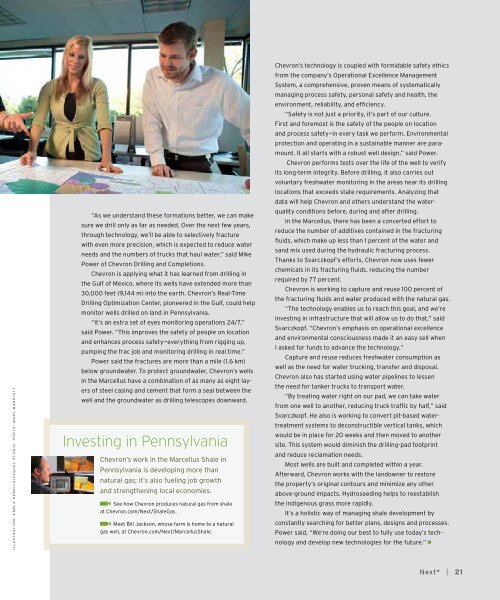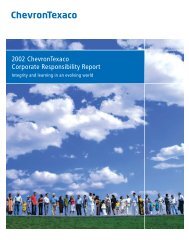Next* Magazine, Issue 5 - Chevron
Next* Magazine, Issue 5 - Chevron
Next* Magazine, Issue 5 - Chevron
Create successful ePaper yourself
Turn your PDF publications into a flip-book with our unique Google optimized e-Paper software.
ILLUSTRATION: KARLA HENRICK/SEQUEL STUDIO; PHOTO: MARC MARRIOTT<br />
“As we understand these formations better, we can make<br />
sure we drill only as far as needed. Over the next few years,,<br />
through technology, we’ll be able to selectively fracture<br />
with even more precision, which is expected to reduce water<br />
needs and the numbers of trucks that haul water,” said Mike<br />
Power of <strong>Chevron</strong> Drilling and Completions.<br />
<strong>Chevron</strong> is applying what it has learned from drilling in<br />
the Gulf of Mexico, where its wells have extended more than<br />
30,000 feet (9,144 m) into the earth. <strong>Chevron</strong>’s Real-Time<br />
Drilling Optimization Center, pioneered in the Gulf, could help<br />
monitor wells drilled on land in Pennsylvania.<br />
“It’s an extra set of eyes monitoring operations 24/7,”<br />
said Power. “This improves the safety of people on location<br />
and enhances process safety—everything from rigging up,<br />
pumping the frac job and monitoring drilling in real time.”<br />
Power said the fractures are more than a mile (1.6 km)<br />
below groundwater. To protect groundwater, <strong>Chevron</strong>’s wells<br />
in the Marcellus have a combination of as many as eight layers<br />
of steel casing and cement that form a seal between the<br />
well and the groundwater as drilling telescopes downward.<br />
Investing in Pennsylvania<br />
<strong>Chevron</strong>’s work in the Marcellus Shale in<br />
Pennsylvania is developing more than<br />
natural gas; it’s also fueling job growth<br />
and strengthening local economies.<br />
See how <strong>Chevron</strong> produces natural gas from shale<br />
at <strong>Chevron</strong>.com/Next/ShaleGas.<br />
Meet Bill Jackson, whose farm is home to a natural<br />
gas well, at <strong>Chevron</strong>.com/Next/MarcellusShale.<br />
<strong>Chevron</strong>’s technology is coupled with formidable safety ethics<br />
from the company’s Operational Excellence Management<br />
System, a comprehensive, proven means of systematically<br />
managing process safety, personal safety and health, the<br />
environment, reliability, and efficiency.<br />
“Safety is not just a priority, it’s part of our culture.<br />
First and foremost is the safety of the people on location<br />
and process safety—in every task we perform. Environmental<br />
protection and operating in a sustainable manner are paramount.<br />
It all starts with a robust well design,” said Power.<br />
<strong>Chevron</strong> performs tests over the life of the well to verify<br />
its long-term integrity. Before drilling, it also carries out<br />
voluntary freshwater monitoring in the areas near its drilling<br />
locations that exceeds state requirements. Analyzing that<br />
data will help <strong>Chevron</strong> and others understand the waterquality<br />
conditions before, during and after drilling.<br />
In the Marcellus, there has been a concerted effort to<br />
reduce the number of additives contained in the fracturing<br />
fluids, which make up less than 1 percent of the water and<br />
sand mix used during the hydraulic fracturing process.<br />
Thanks to Svarczkopf’s efforts, <strong>Chevron</strong> now uses fewer<br />
chemicals in its fracturing fluids, reducing the number<br />
required by 77 percent.<br />
<strong>Chevron</strong> is working to capture and reuse 100 percent of<br />
the fracturing fluids and water produced with the natural gas.<br />
“The technology enables us to reach this goal, and we’re<br />
investing in infrastructure that will allow us to do that,” said<br />
Svarczkopf. “<strong>Chevron</strong>’s emphasis on operational excellence<br />
and environmental consciousness made it an easy sell when<br />
I asked for funds to advance the technology.”<br />
Capture and reuse reduces freshwater consumption as<br />
well as the need for water trucking, transfer and disposal.<br />
<strong>Chevron</strong> also has started using water pipelines to lessen<br />
the need for tanker trucks to transport water.<br />
“By treating water right on our pad, we can take water<br />
from one well to another, reducing truck traffic by half,” said<br />
Svarczkopf. He also is working to convert pit-based watertreatment<br />
systems to deconstructible vertical tanks, which<br />
would be in place for 20 weeks and then moved to another<br />
site. This system would diminish the drilling-pad footprint<br />
and reduce reclamation needs.<br />
Most wells are built and completed within a year.<br />
Afterward, <strong>Chevron</strong> works with the landowner to restore<br />
the property’s original contours and minimize any other<br />
above-ground impacts. Hydroseeding helps to reestablish<br />
the indigenous grass more rapidly.<br />
It’s a holistic way of managing shale development by<br />
constantly searching for better plans, designs and processes.<br />
Power said, “We’re doing our best to fully use today’s technology<br />
and develop new technologies for the future.” ■<br />
<strong>Next*</strong> | 21

















